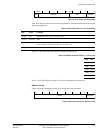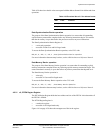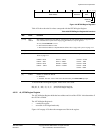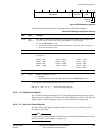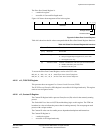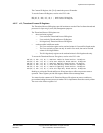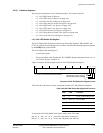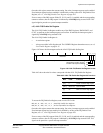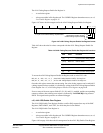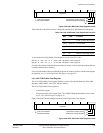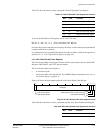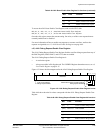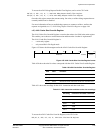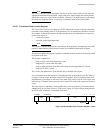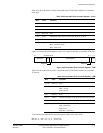
System Control Coprocessor
ARM DDI 0363E Copyright © 2009 ARM Limited. All rights reserved. 4-64
ID013010 Non-Confidential, Unrestricted Access
c15, nVAL Reset Enable Set Register
The nVAL Reset Enable Set Register enables any of the PMC Registers, PMC0-PMC2, and
CCNT, to generate a reset request on overflow. If enabled, the reset request is signaled by
nVALRESET being asserted LOW.
The nVAL Reset Enable Set Register is:
• A read/write register.
• Always accessible in Privileged mode. The USEREN Register determines access, see c9,
User Enable Register on page 6-15.
Figure 4-46 shows the bit arrangement for the nVAL Reset Enable Set Register.
Figure 4-46 nVAL Reset Enable Set Register format
Table 4-44 shows how the bit values correspond with the nVAL Reset Enable Set Register.
To access the nVAL Reset Enable Set Register, read or write CP15 with:
MRC p15, 0, <Rd>, c15, c1, 2 ; Read nVAL Reset Enable Set Register
MCR p15, 0, <Rd>, c15, c1, 2 ; Write nVAL Reset Enable Set Register
On reads, this register returns the current setting. On writes, reset requests can be enabled. If a
reset request has been enabled, it is disabled by writing to the nVAL Reset Enable Clear
Register. See c15, nVAL Reset Enable Clear Register on page 4-67.
If one or more of the reset request fields (P2, P1, P0, and C) is enabled, and the corresponding
counter overflows, then a reset request is indicated by nVALRESET being asserted LOW. This
signal can be passed to a system reset controller.
c15, nVAL Debug Request Enable Set Register
The Debug Request Enable Set Register enables any of the PMC Registers, PMC0-PMC2, and
CCNT, to generate a debug request on overflow. If enabled, the debug request is signaled by
VALEDBGRQ being asserted HIGH.
C
31 3210
Reserved
P2
P1
P0
Performance monitor counter
overflow reset request enables
Cycle count overflow reset request enable
Table 4-44 nVAL Reset Enable Set Register bit functions
Bits Field Function
[31] C CCNT overflow reset request
[30:3] Reserved UNP or SBZP
[2] P2 PMC2 overflow reset request
[1] P1 PMC1 overflow reset request
[0] P0 PMC0 overflow reset request



